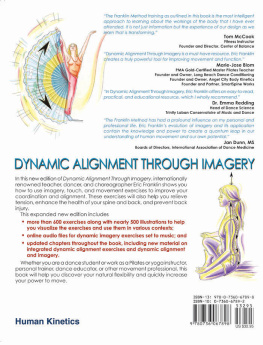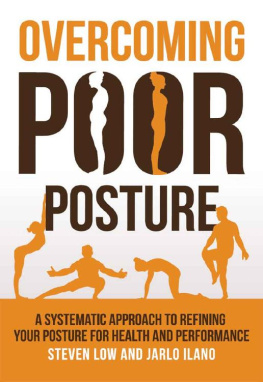

Second Edition

Dynamic Alignment
Through Imagery
Eric Franklin

Library of Congress Cataloging-in-Publication Data
Franklin, Eric N.
Dynamic alignment through imagery / Eric Franklin. -- 2nd ed.
p. cm.
Includes bibliographical references and index.
ISBN-13: 978-0-7360-6789-8 (soft cover)
ISBN-10: 0-7360-6789-2 (soft cover)
1. Dance--Physiological aspects. 2. Posture. 3. Body image. 4. Mind and body. I. Title.
RC1220.D35F73 2012
615.85155--dc23
2011037066
ISBN-10: 0-7360-6789-2 (print)
ISBN-13: 978-0-7360-6789-8 (print)
Copyright 2012 by Eric Franklin
All rights reserved. Except for use in a review, the reproduction or utilization of this work in any form or by any electronic, mechanical, or other means, now known or hereafter invented, including xerography, photocopying, and recording, and in any information storage and retrieval system, is forbidden without the written permission of the publisher.
The web addresses cited in this text were current as of November 2011, unless otherwise noted.
Acquisitions Editors: Judy Patterson Wright, PhD, and Gayle Kassing, PhD; Developmental Editor: Ray Vallese; Assistant Editor: Derek Campbell; Copyeditor: Jan Feeney; Indexer: Marie Rizzo; Permissions Manager: Martha Gullo; Graphic Designer: Joe Buck; Graphic Artist: Denise Lowry; Cover Designer: Keith Blomberg; Photographer (cover): Alexander Yakovlev/fotolia. com (top), PhotoDisc (right), Eyewire (bottom); Photographer (interior): Eric Franklin, unless otherwise noted; Photo Asset Manager: Laura Fitch; Visual Production Assistant: Joyce Brumfield; Photo Production Manager: Jason Allen; Art Manager: Kelly Hendren; Associate Art Manager: Alan L. Wilborn; Illustrations: Eric Franklin; Printer: Sheridan Books
Printed in the United States of America 10 9 8 7 6 5 4 3 2 1
The paper in this book is certified under a sustainable forestry program.
Human Kinetics
Website: www.HumanKinetics.com
United States: Human Kinetics, P.O. Box 5076, Champaign, IL 61825-5076
800-747-4457
e-mail:
Canada: Human Kinetics, 475 Devonshire Road Unit 100, Windsor, ON N8Y 2L5
800-465-7301 (in Canada only)
e-mail:
Europe: Human Kinetics, 107 Bradford Road, Stanningley, Leeds LS28 6AT, United Kingdom
+44 (0) 113 255 5665
e-mail:
Australia: Human Kinetics, 57A Price Avenue, Lower Mitcham, South Australia 5062
08 8372 0999
e-mail:
New Zealand: Human Kinetics, P.O. Box 80, Torrens Park, South Australia 5062
0800 222 062
e-mail:
E4014
Contents
Chapter 6 General Guidelines Before Using Imagery
Counterrotation and Three-Dimensional Alignment
Introduction: How I Came to Use Imagery
A t the Gymnasium Freudenberg (Mountain of Joy), the Swiss Latin preparatory school in Zurich that I attended for six and a half years, I learned many valuable things. My back, however, acquired the skill of stooping over Latin verse for hours on end. The schools rigorous class schedule, which started at 7:10 a.m., was hardly what you might expect in a gymnasium, a place where physical activity takes place. At the Gymnasium Freudenberg, little emphasis was placed on sports: There was no football team, no track teamor any team for that matter. But I loved to dance, and in the evenings I danced and exercised in the cellar at home, alone or with my brother. When I graduated from school, therefore, my posture was not as bad as it might have been, although it took years to reverse the Latin-verse effect.
When the school put on its first theatrical production, to my surprise I was selected to play the lead. I knew nothing about auditioning, but I had apparently struck the right note. I remember being told that I didnt have to do much to be funny. I wasnt sure what the director meant by this statement until I rolled onto the stage for the first time. We were producing Molires Le Bourgeois Gentilhomme, and I played a rather simple-minded, rich bourgeois trying to learn to dance. As I bounced about the stage with great enthusiasm during rehearsal, the fellow playing the dance teacher was very perturbed. His dancing was, of course, supposed to look totally superior to mine. Finally, I learned to look clumsy. I believe my trick in achieving this awkwardness was to imagine my legs wiggling like rubber and my neck stiff as an oak. (You are welcome to try it.)
When I first attended a ballet class, the teacher told me that my back was crooked as a banana. This correction was given in the strict Swiss manner of teaching: First teachers told you how sorry you looked and then they yanked you into the right shape. The remark was delivered with an undertone of How dare you show up in class with that kind of back! I can still see the outraged look on the teachers face, which naturally made me feel sad and self-conscious. I wondered how to straighten my back. I was taught the pulling-up method, which seemed to be the standard procedure. My navel was supposed to stick to my lumbar spine, my buttocks needed to tuck under somehow, and my chin had to recede. The question was how anyone could enjoy dancing in this position. Breathing seemed out of the question. My back didnt actually feel like a banana, so I kept trying to imagine what the teacher was seeing. I tried to imagine my back in a position that would justify such a cry of indignation. But this didnt bring me closer to solving the problem.
I now know that I was actually reinforcing the opposite of what I wanted. If you dont want your back to look crooked, you shouldnt focus on it not being crooked as a banana. Instead you need to replace the image of a banana with that of something straight yet flexiblea waterspout, for example. Put simply, your mind is a large screen filled with the images you have absorbed throughout the day. Your mind is instructed by these images and the thoughts that accompany them. The problem is that most of your 20,000 or so thoughts, flashing images, notions, and so on are similar to those of the previous day. As the images and thoughts repeat, they slowly but steadily bring about a change in the direction the images suggest. According to Indian Ayurvedic medicine, if you want to know what thoughts you have had in your life so far, you should look at your body (Chopra 1990a). To help clarify the connection between thought process and posture, try the following experiment:
Next page









